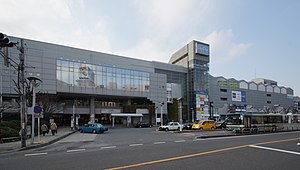Hon-Kawagoe Station
|
Hon-Kawagoe Station
本川越駅 |
|
|---|---|

The east side of Hon-Kawagoe Station in February 2016
|
|
| Location | 1-22 Shintomi-chō, Kawagoe-shi, Saitama-ken 350-0043 Japan |
| Operated by |
|
| Line(s) |
|
| Distance | 47.5 km from Seibu-Shinjuku |
| Connections |
|
| Other information | |
| Station code | SS29 |
| Website | www |
| History | |
| Opened | 21 March 1895 |
| Previous names | Kawagoe (until 1940) |
| Traffic | |
| Passengers (FY2013) | 48,920 daily |
| Location | |
Hon-Kawagoe Station (本川越駅 Honkawagoe-eki?) is a railway station on the Seibu Shinjuku Line in Kawagoe, Saitama, Japan, operated by the private railway operator Seibu Railway. This is one of three main stations of the city; the other two are Kawagoe Station and Kawagoeshi Station.
Hon-Kawagoe Station is the terminus of the 47.5 km Seibu Shinjuku Line from Seibu-Shinjuku Station in Tokyo.
The station is approximately 5 minutes' walk from Kawagoeshi Station on the Tobu Tojo Line, and 15 minutes' walk from Kawagoe Station on the JR Kawagoe Line and Tobu Tojo Line).
Track diagram
The station has three terminating tracks situated at ground level. The main ticket barriers are located on the ground floor level, with additional ticket barriers on the second floor providing direct access to the adjoining Pepe department store.
The west side of the station in February 2016
The east entrance in February 2016
The ground-floor ticket barriers in February 2016
The view from the end of the platforms
The station opened as Kawagoe Station on the Kawagoe Railway on March 21, 1895. The station name was changed to the present name on July 22, 1940, following the opening of Kawagoe Station on the Kawagoe Line of Japanese Government Railways. On October 20, 2012 the station acquired the secondary name Toki no Kane to Kura no Machi (時の鐘と蔵のまち?) in order to encourage more tourists to visit the area. The name is a reference to the nearby 19th-century clock tower and storehouses.
...
Wikipedia

